78 Search Results for object symbols
June 28, 2016
by Carole Zangari -
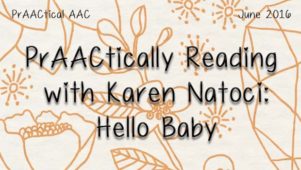
Karen Natoci is back with some wonderful suggestions for reading and building AAC skills with young children. Although her focus is on little ones with visual impairment, these books and the implementation suggestions, would be useful for a wide range babies, toddlers, and preschoolers who are developing their language skills. Enjoy! :::::::::::::::::::::::::::::::::::::::::::::: Books Hello Baby Words (high contrast board books) by Roger Priddy, illustrated by Holly Jackman (Published by St. Martin’s Press, 175 Fifth Avenue, NY 10010) Hello Baby Words: On The Go Hello Baby Words: Faces Hello Baby: Animals Hello Baby: Faces Core Vocabulary Focus: GO, GET, WHO, THAT, SEE, IT Fringe Vocabulary Transportation: digger, balloon, train, roller skates, helicopter, truck, car, submarine, rocket, dump truck, fire truck, boat, race car, tractor, car carrier, plane Animals: cat, turtle, fish, pig, butterfly, cow, mouse, bird, bear, zebra, rabbit, panda, penguin, dog, sheep, snake Faces: boy, girl, woman, man, grandfather, grandmother... [Read More...]
June 1, 2016
by Carole Zangari -

Today, we welcome back Vicki Clarke with more helpful information on conducting AAC assessments. If you work with individual who are at the early stages of communicative development, this post is for you! :::::::::::::::::::::::::::::::::::::::::::::::::::::::::: Some of my most favorite students are those who, at first, may not seem to notice me at all. Sometimes these students seem to exist in their own worlds. They don’t seem to respond in ways we would expect: looking, attending, listening, or gesturing. They may have a diagnosis of Autism, significant developmental delay, epilepsy, or any number of syndromes. I love these kids, and unfortunately, these are often the students who don’t get referred to me. Sometimes it takes years of working in a district before I get to see students with significant developmental delays. These children are typically served in classrooms for students considered to be severe/profound or multi-handicapped. Honestly, I usually get the... [Read More...]
March 24, 2016
by Carole Zangari -
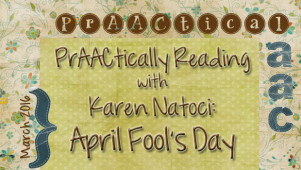
It’s gratifying to hear from so many of you who are including storybook reading in your AAC instruction and therapy. We welcome back Karen Natoci, Assistant Professor and SLP Oregon Health and Science University’s Child Development Rehabilitation Center. She serves on the Neurodevelopment and Rett Evaluation teams and has a caseload of children with Complex Communication Needs and AAC. Karen tells us that “I know very well the feeling of being overwhelmed by the high needs of students with complex communication needs and will readily admit that you have to have a very large ‘toolbox’ of ideas!” Currently, she is on the charter development team to create the Communication Matrix- Virtual Community of Practice with Charity Rowland. At the end of the day, Karen enjoys running, practicing piano, and exploring Portland and the Oregon coast. :::::::::::::::::::::::::::::::::::::::::::::::::::::::::::::::::::::::::::::::::::::::::::::::::: Book: April Fool’s Day Written and Illustrated by Dee Smith (Also available from Deesignery.com) Core Vocabulary focus: Look,... [Read More...]
February 25, 2016
by Carole Zangari -
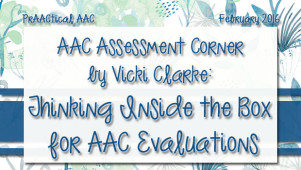
AAC assessment is a challenge in almost every service delivery setting, and many of you have reached out to us to ask for advice on how to strengthen your assessment practices. Luckily, Vicki Clarke, an AAC Chick who has a great deal of experience assessing learners in clinical and educational settings, has tips and resources to share. In this continuation of the AAC Assessment Corner series, Vicki talks about a key feature in any AAC system: vocabulary organization. ::::::::::::::::::::::::::::::::::::::::::::::::::::::::::::::::::::::::::::::::::::::::::::: Thinking Inside the Box for AAC Evaluations: What Type of Vocabulary Organization is Right For Your AAC User? Professionals often spend a great deal of time concerning themselves with which box they should get their AAC user. Should I pick a Prentke Romich or a Tobii Dynavox? But what about the iPad? And what about the money? Should I pick a CheapTalk or a GoTalk instead? Here’s the good news: The box is not the... [Read More...]
October 27, 2015
by Carole Zangari -

As far as I can tell, most AAC learners are taught by people who don’t specialize in AAC. Their school SLPs may have caseloads of 50, 60, 70, or more students with IEPs, 90% of whom have goals for articulation, language, and fluency. Their classroom teachers serve students whose disabilities range from none at all, to dyslexia to cerebral palsy, to significant intellectual disabilities, and everywhere in between. In all likelihood, neither group had much AAC training. What little AAC they know, they’ve picked up on their own from reading, going to workshops and conferences (usually self-funded), talking to colleagues, and exploring online resources. Many times, their first foray into AAC is with things like choice boards and visual supports, such as daily schedules and first/then boards. From there, they may begin labeling the environment with pictures symbols (e.g., ‘table’ on the table, ‘on/off’ near the light switch), using mini-schedules... [Read More...]
October 19, 2015
by Carole Zangari -
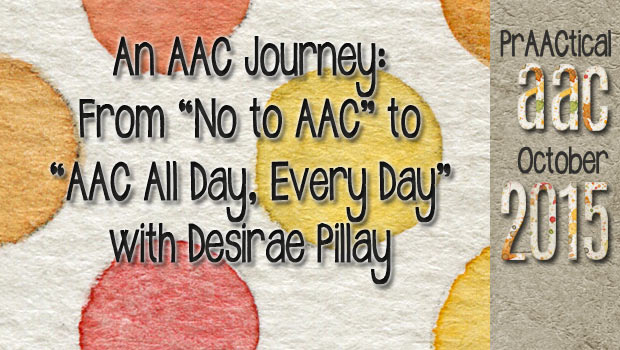
What better way to celebrate AAC Awareness Month than to share AAC stories from around the world? In this post, we welcome Desirae Pillay, who shares a bit about her daughter, Savannah, and their AAC journey. As the mother of a young adult with ASD and cerebral palsy, Desirae has taken what she has learned about AAC and is using it to help others outside of her family. Desirae began her journey with AAC in 2003 when she could not find a qualified AAC specialist to assist her with her daughter. Her experience and informal learning gained her a job for an AT company. When her daughter’s health needs became pressing, she resigned her job and worked part time as a Disability Consultant for various organisations. Desirae recently returned to work as an AT Advisor, where she trains on a range of topics about communication for people with disabilities. Her passion is for... [Read More...]
November 25, 2014
by Carole Zangari -
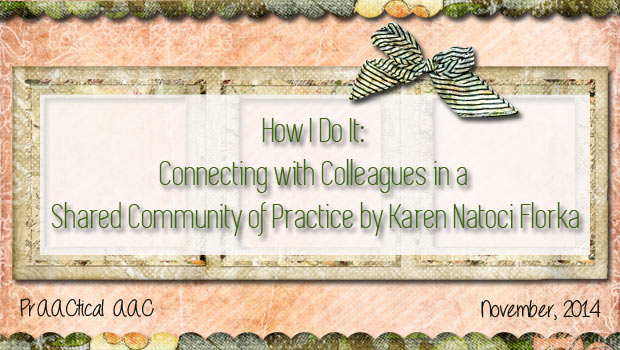
I had the pleasure of meeting Karen Natoci Florka last month when I visited Michigan and am delighted that she was willing to introduce us to the Shared Community of Practice from the team at The Communication Matrix. Karen is an SLP who has served students aged 3-26 with various physical, sensory and intellectual challenges at Wing Lake Developmental Center (Detroit area) since 2001. She is a part time lecturer at Wayne State University where she teaches a course entitled “Communication Acquisition and Educational Interventions for Students with Moderate to Severe Impairments.” She is part of the Communication Matrix Charter group. Click on the image below to learn more. The Communication Matrix is growing into a Shared Community of Practice! I remember the first few weeks in my new job at a wonderful, magical, school for children with complex communication needs. It was time for my first evaluation. These amazing students were challenging! They seemed... [Read More...]
September 9, 2014
by Carole Zangari -
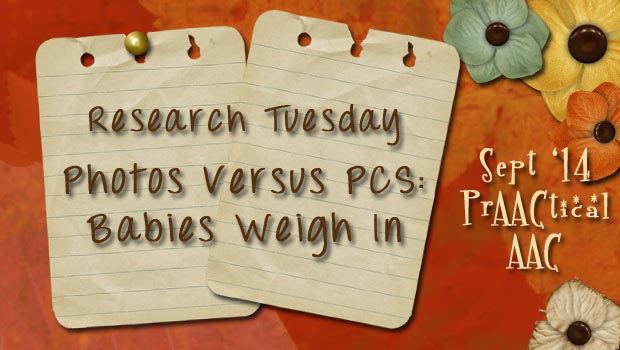
We’re back again with another Research Tuesday post, a series organized by Rachel Wynn of Gray Matter Therapy, in which bloggers are encouraged to write about a research article that they’ve read recently. (You may also know Rachel from her amazing work in advocating for ethical services in skilled nursing facilities.) For our September post, we look at a study done with babies to see how they like different AAC symbols. SLPs frequently assume that children with AAC needs better understand and prefer photos to other forms of picture symbols used in AAC. In this article, we look at the work of special educator Alexandra DaFonte whose work gives us some insight into this issue. In this study, she sought to determine if typically developing infants at 6, 9, and 12 months of age responded to two types of graphic symbols used in AAC: actual photographs and Picture Communication Symbols... [Read More...]
May 29, 2014
by Carole Zangari -
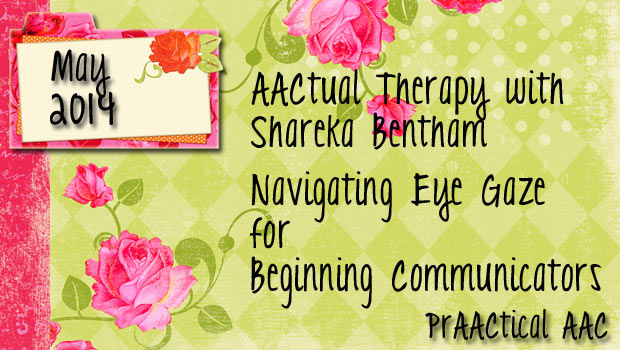
Today, we welcome back Shareka Bentham, who has told us about her AAC adventures with the Harlem Shake, a field trip, and more. In this post, she shares her experiences in getting little ones started on the intentional use of eye gaze for communication. ::::::::::::::::::::::::::::::::::::::::::::::::::::::::: I think that most Speech & Language Therapists have those moments in therapy where they’re wondering “Am I doing the right thing here??” I have been feeling that way recently in my practice as I have been nudged into the world of using the head and eyes for communication. I was (with extensive research) once able to use an eye gaze board quite successfully with an adult patient in the final stages of ALS, but I had never used such techniques in my paediatric clinic. However, I now have a few little ones on my caseload who have severe physical limitations, and are unable to... [Read More...]
April 10, 2014
by Carole Zangari -
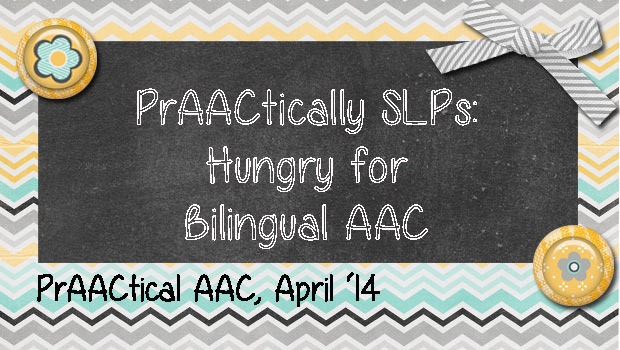
We are so excited to launch, PrAACtically SLPs, a new series featuring the voices of graduate students in SLP programs who do outstanding work in AAC. We start off with a wonderful group from the University of North Carolina at Chapel Hill. Allie Rodriguez, Caitlin Rich, and Megan Latta are second year SLP students who will be graduating in May. They recently concluded an AAC course taught by Dr. Penny Hatch, who continues to mentor them in the field of AAC and literacy. I met these energetic young professionals at the North Carolina Augmentative Communication Association Conference in February and was inspired by their passion. In this post, they tell us about their AAC experiences on a trip to Guatemala. Hungry for Bilingual AAC? Today, our population is becoming more culturally diverse, which, in turn, has caused our caseloads to reflect this change. There is a growing... [Read More...]









